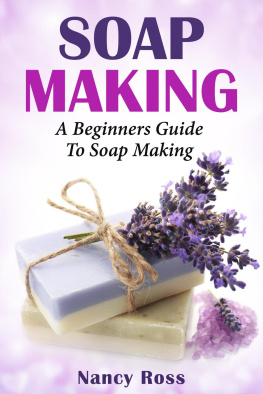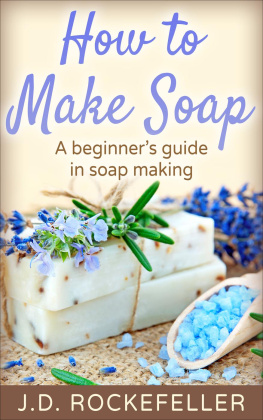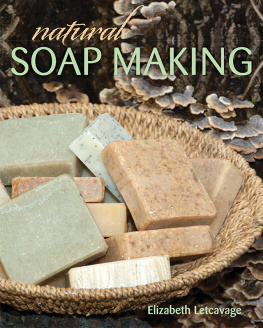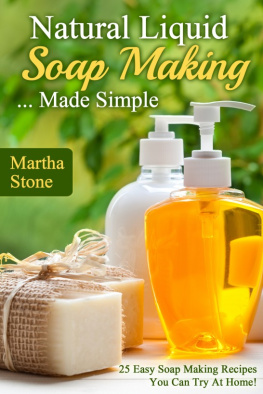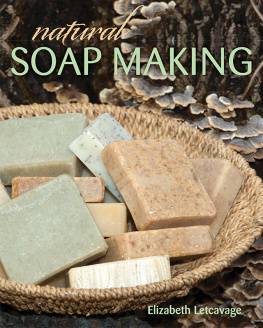SoapMaking From Scratch
TheUltimate Guide To Making And Selling Soap
By:April Weatherly
Tableof Contents
Publishers Notes
Disclaimer
This publicationis intended to provide helpful and informative material. It is not intended todiagnose, treat, cure, or prevent any health problem or condition, nor isintended to replace the advice of a physician. No action should be taken solelyon the contents of this book. Always consult your physician or qualifiedhealth-care professional on any matters regarding your health and beforeadopting any suggestions in this book or drawing inferences from it.
The author andpublisher specifically disclaim all responsibility for any liability, loss orrisk, personal or otherwise, which is incurred as a consequence, directly orindirectly, from the use or application of any contents of this book.
Any and allproduct names referenced within this book are the trademarks of theirrespective owners. None of these owners have sponsored, authorized, endorsed,or approved this book.
Always read allinformation provided by the manufacturers product labels before using theirproducts. The author and publisher are not responsible for claims made bymanufacturers.
2013
Manufactured inthe United States of America
Dedication
This book isdedicated to those who, like my parents still believe that nothing beats thehomemade product.
Chapter 1- What Is Soap Making?
Soap has been made by hand forthousands of years. Up until as recently as the 1920s, if you wanted soap, youmade it in your home or bought it from someone who did. It was only theshortage of animal fats during the First World War that caused the switch tocommercial synthetic detergents. In the last decade or so, the art of makingsoap has come full circle, as a hobby and craft for some and a businessopportunity for others.

Making Soap through the Ages
The most popular origin story forsoap comes from the Roman Empire. Mount Sapo was used for animal sacrifices,which soaked the mountain with animal fats and the ashes of sacrificial fires.During a heavy rain, this mixture reacted to form soap, which flooded into theriver below. There, washerwomen discovered the substance and its cleaningproperties.
Of course, this story is completelyfalse. There is no mountain named Mount Sapo, and in fact the name Sapo comesfrom the Latin word for tallow, which was a type of animal fat used for soapmaking. The true origin of soap is much older.
In 2200 B.C., soap was a commonproduct in the ancient Babylonian empire. The recipe was simple: mix water,ashes and alkali salt. This recipe was found on a stone tablet and proves howlittle soap has changed.
World War 1 led to the widespreaduse of synthetic detergents, and the lack of readily available animal fat meanthandmade soap needed a different source of fatty acids. Today we use vegetableoils for this purpose. The ashes used throughout history were likewise refinedand the active ingredient extracted. Today we use sodium hydroxide.
How Soap Is Made
As mentioned above, soap is made ofthree main ingredients. These ingredients are a vegetable oil -- typicallycoconut and olive oils work best -- sodium hydroxide and water. Sodiumhydroxide is a caustic chemical and a highly alkaline substance, which is whyit reacts with the oils to form soap. It is also known as lye.
The method used to make soap throughthe ages is known today as the cold process. In one container, the soap makermixes an amount of water with an amount of lye. The oils used determine theexact amounts. Each of the oils has what is known as a saponification index.This is a number that identifies how much lye it takes to completely react withthat oil to make soap with no leftover lye or oil. In the second container, thesoap maker mixes the oils they want to use.
In cold process soap, fragrances andcolors are added when all the ingredients are mixed together. It is alsopossible to melt the finished soap bars to add the color and scent oils later,in a process known as French Milling.
Cold process soap, when the oil andlye are mixed together, is poured into molds to sit and cure. This processtakes six weeks or longer.
In modern times, soap makers haveadded heat to this process. Adding heat forces the saponification of theingredients at a much higher rate. In other words, after only a short timeboiling, the lye and oil will have completely reacted and formed soap. Themixture is poured into molds and allowed to harden, at which point it is readyto use. This is appropriately named the hot process.
Many hobbyists have taken up themelt and pour method of soap making in recent years. Instead of beginning withraw chemicals, this method begins with a bar of clear, unscented soap. Thissoap base is then melted so that scent oils and colors can be added. It is thenpoured into molds and allowed to harden. This method does not involve dangerouschemicals, and as such is perfect for crafting with children or as a hobby.
Saponification
The chemical reaction between lyeand fat is called saponification, after the Latin root word sapo, meaning soap.Any fatty acid, from animal fat to vegetable oil, will undergo this processwhen exposed to lye. Sodium hydroxide is used simply because it forms a hardbar of soap when the reaction is complete. Potassium hydroxide can be usedinstead to make liquid soap.
Saponification works in othercircumstances as well. The reaction is used with other substances to createliquid lubricants like lithium grease. It is also the process used in certainfire extinguishers. Grease fires burn too hot to be put out by standard dryextinguishers, so wet chemical methods are used. Part of this is a compoundthat reacts with the grease to create soap.
In the art world, saponification isa hazard of certain paints. Oil paints in history have been warped or destroyedby the saponification process, where the oil in the paint slowly reacts with analkali metal in the pigment.
Soap for Business and Pleasure
The melt and pour method is gainingpopularity in recent years as a hobby or craft. Its an excellent, safe craftto do with children, and allowing them to mix their own scents and colors willgive them something fun to do. Other people take up soap making as a hobby,using detailed molds and careful color selections to create soaps that areworks of art. They work well as gifts or as items to sell in a home business.The Internet makes this possible, allowing anyones home business to reach aworldwide audience.
Chapter 2- What Are the Benefitsof Making Your Own Soap?
"DIY" is a term that hasbecome quite popular in today's world. Individuals are looking to enhance theircreative sides, and they are also trying to find ways to save money. As aresult, some have started to make their own soap. What are some of the benefitsassociated with this process?
Your Budget Will Thank You
Look at all of the different thingsyou spend money on each week. Soap is probably one of them. Even if you stockup on soap at the sales, you are probably spending too much money for an itemthat can be made at home. You will likely start by making bar soap, so you'llbe able to stock all of the soap dishes and showers in your house. When you areable to move onto liquid soap, then you can really save a lot of money eachmonth.
Better for Your Skin
So many different ingredients gointo the soap-making process. You never know what types of ingredients are usedin the ones you purchase at the store. Of course, you could look at theingredients list on the back. But what are the chances that you know what eachand every one of them are? When you start to make soap in your own home, youare definitely taking a more natural approach. Since the natural and organicmovements have a huge presence in today's society, you are probably aware ofhow much better making your own is for you.
Next page

